Physical Address
304 North Cardinal St.
Dorchester Center, MA 02124
Basic musculoskeletal anatomy needs to be understood when managing orthopaedic care. The normal locomotor system relies on a stable skeleton to provide attachment for muscles and a base for positioning the hands and feet in space.
The axial skeleton consists of the skull, spine and rib cage ( Fig. 11.1A ). The appendicular skeleton evolved from fins in early fish to form the limbs (arms, shoulder girdle, legs and pelvis, Fig. 11.1B ). The skeleton is the foundation for musculotendinous attachment allowing locomotion, support, protection, haematopoiesis, mineral storage and endocrine regulation.
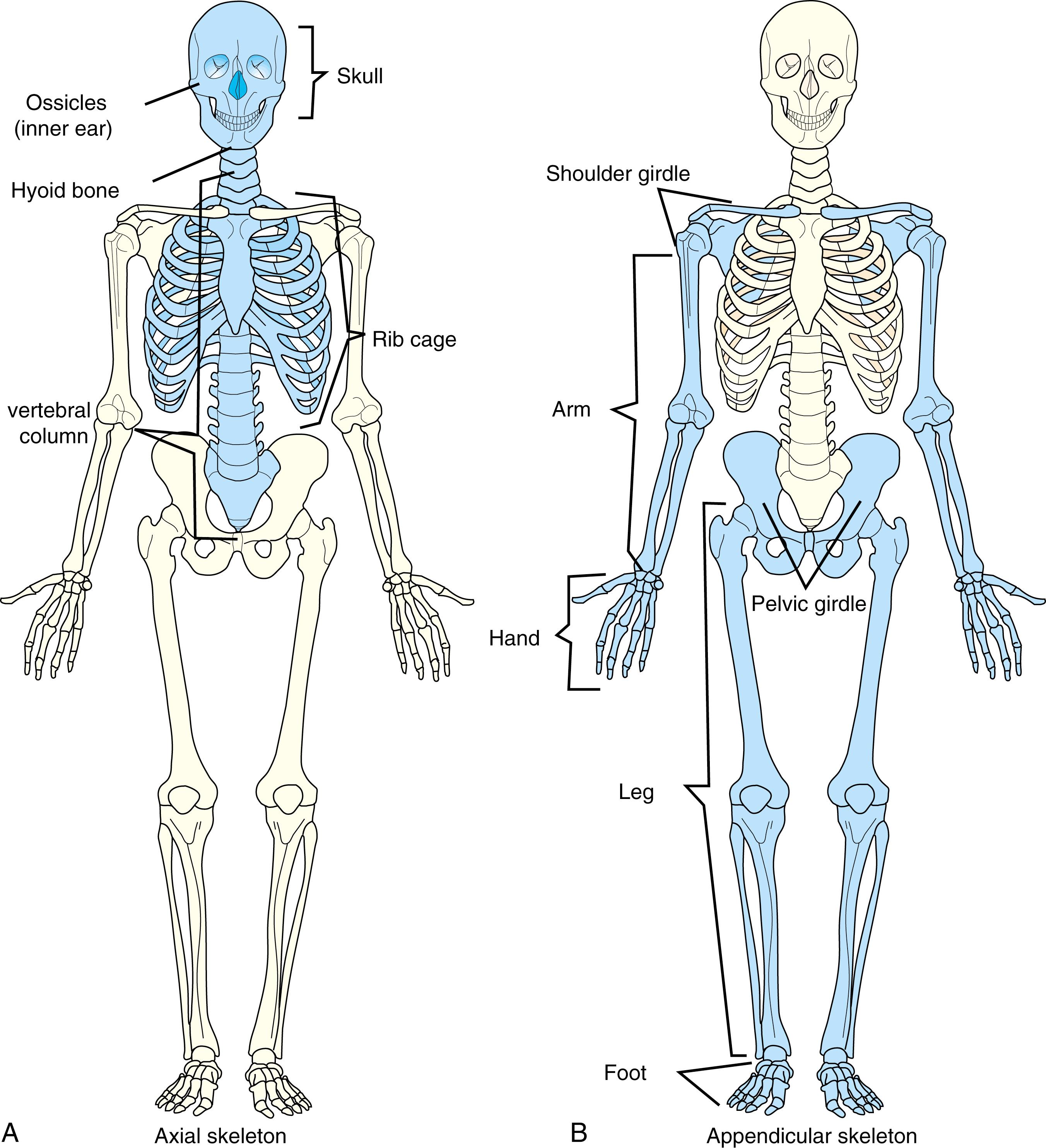
Bone consists of an inorganic component (60% dry weight) and an organic matrix (40% dry weight). The inorganic calcium hydroxyapatite provides compressive strength and rigidity whilst the organic component, which is 90% collagen (primarily type 1), provides the tensile strength through its triple helix structure.
Bones can be classified by their shape (long vs. flat) , macroscopic structure (cortical vs. cancellous) and microscopic structure (lamellar vs. woven) . Long bones (e.g., femur, humerus, forearm, metacarpal and metatarsal bones) have three regions: epiphysis, metaphysis and diaphysis ( Fig. 11.2 ). Flat bones ( e.g., cranium, pelvis, scapula) are composed of cortical bone enclosing a minimal trabecular region.
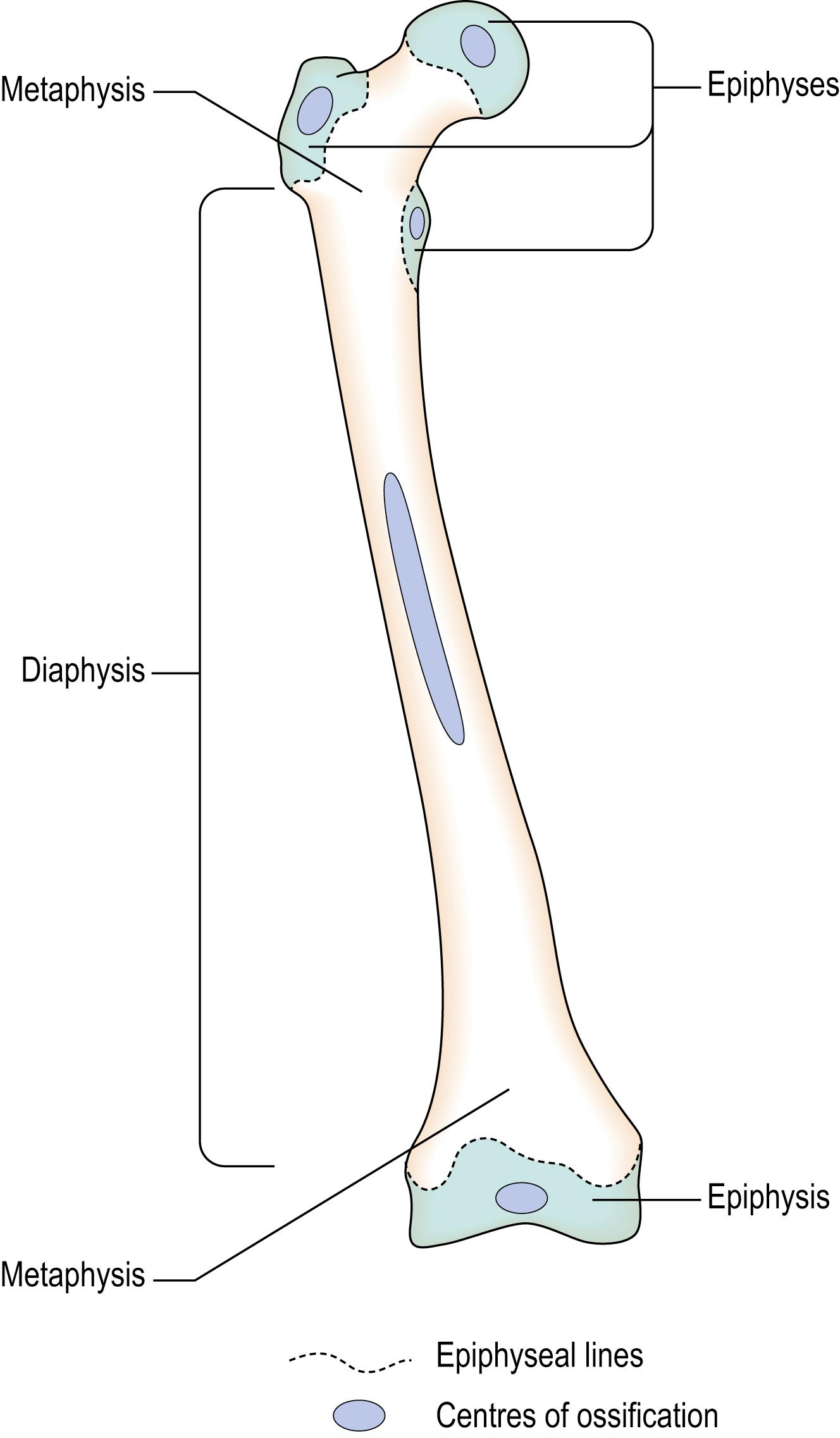
Periosteum consists of fibrous (fibroblastic) and inner cambium (osteogenic) layers and is tightly bonded to bone by Sharpey fibres. It covers the outer surface of all bones, except at the joints of long bones. Cortical bone has a slow turnover (formation and removal) and consists of packed Haversian systems (osteons, neurovascular canals and interstitial lamellae) which give bone its strength. Cancellous bone is softer, porous, more elastic and has a higher turnover, undergoing ‘stress-dependant’ remodelling. Woven bone is immature or pathological bone. It is typically weaker, more flexible, has a high turnover rate and greater osteocyte density than lamellar bone.
A good clinical history and thorough examination is essential. Decision making in orthopaedics and fracture management never rests purely on x-ray or magnetic resonance imaging (MRI) scan findings. Factors to be considered before imaging include:
Age: many fractures and orthopaedic conditions are very age specific.
Occupation: some occupations are more likely to produce orthopaedic problems but, in addition, knowing a patient’s occupation (and hobbies) gives insight into their financial responsibilities and aspirations. Retired people too have aspirations. Being interested in your patient as a whole helps them help you with their management.
History of the main complaint:
Pain: most orthopaedic problems cause pain. History includes direct questions to ascertain the following characteristic of the pain: how long has it been present; where is it felt; does it radiate; the quality of the pain; is there associated numbness, paraesthesia or weakness; when does it occur; is there associated stiffness?
Deformity: indicates the alignment of a body part is abnormal.
Are there other bone or joint problems?
How does the problem affect the patient’s activities and life generally?
Family history—enquire about possible inherited diseases but tread carefully: there may be issues of perceived guilt when speaking to a child’s parents.
Examination: simply ‘Look, feel and move’ was advocated years ago but is not enough; you must take account of the whole patient and not just the part in question:
Look with the patient appropriately undressed; look for deformity by comparing the sides. Look at the skin. Look at the hands—thick skin indicates a heavy physical activity and usually means the patient has recently been able to lift heavy items.
Feel for tenderness but be gentle. Feel for lumps. Do not forget to palpate pulses.
Passively move the part to check the range of movement, but be sure not to hurt the patient—watch their face. Estimate the range of movement in degrees from the ‘anatomical position’. It is often easiest to estimate range starting from a right angle.
Active movement : is estimated when detecting weakness and is essential in patients with neuromuscular disease. The Medical Research Council grading of weakness is frequently used:
0 = No discernible muscle contraction
1 = A flicker of muscle contraction, but insufficient to move joint
2 = Muscle contaction can move joint, but only if gravity is eliminated (and limb weight is counterbalanced)
3 = Muscle contraction is sufficient to move against gravity
4 = Functional but not normal power
5 = Normal
Investigations:
Bloods tests: full blood count; C-reactive protein (CRP) and erythrocyte sedimentation rate if systemic illness seems possible. In possible polyarthritis, a full rheumatological screen including estimation of the serum urate should be performed.
Imaging
X-rays are usually still the first-line imaging. They are cheap and readily accessible, and patients like to know about their x-rays. The usual model is two x-rays at right angles including nearby joints. Radiology of the skeleton in its loaded state can give more information, a “standing” radiograph of a joint will often give more information especially in an arthritic knee or deformed foot. This too applies in spinal fractures, where “stability” can be assessed by comparison of vertebral height/alignment to non-standing radiographs.
Ultrasound gives a dynamic view of soft tissues but bones are not imaged in useful detail. Swellings (including cysts and ganglions), ligaments, muscles and tendons are well evaluated. A dynamic picture of a joint can help in motion disorders or impingement syndromes. Ultrasound guided injections are popular.
Computed tomography (CT) scanning was the first effective three-dimensional (3D) imaging technique and revolutionised spinal imaging, replacing imprecise contrast studies. The speed of data acquisition has increased markedly and the radiation dose has reduced since its inception. CT scans can give detail of bones down to millimetre level. Images can be reformatted into 3D models, for example, for fractures or to plan complex anatomical reconstructions of acetabulum or spine
Magnetic Resonance Imaging (MRI) is increasingly used to give detail of soft tissues, bones and joints. MRI is now the gold standard where x-rays and ultrasound are inadequate. MRI is particularly useful for menisci and ligaments in the knee the spine and nerve roots exiting the spinal cord; tumours; infections; some fractures and to assess synovial thickening (for contraindications, see Ch. 5 ).
Isotope scanning is safe (see Ch. 5 ). Whole body bone scans can show multiple lesions, such as disseminated malignancy. Labelled white cell scanning can pinpoint suspected bone infection.
Positron Emission Tomography (PET) scans are being increasingly used for investigating tumours, both locally and for systemic spread.
Arthroscopy. Accurate diagnosis of a joint injury often requires internal inspection. Arthroscopy is often used shoulder, elbow, wrist and ankle pathology. It is less often in the hip. It is usually performed as a day case under anaesthesia., The arthroscope is connected to a camera so that a magnified view of the joint can be seen on a screen. Therapeutic arthroscopy enables abnormalities to be repaired or material removed. Most procedures take 30 to 45 minutes and recovery is usually rapid, however in more complex surgery such as hip arthroscopy this can take even longer. Arthroscopic techniques have been gradually extended to include ligament reconstruction, rotator cuff repair and cartilage repair. Similar minimal invasive technology is being employed in spinal deformity surgery, as “thoracoscopy”.
Osteotomy: cutting a bone, such as when it needs to be realigned.
Arthrodesis or fusion means that a joint is excised and then the two bone ends are encouraged to heal together as in a fracture healing response.
Arthroplasty is where a joint is removed and replaced with an artificial joint. This may be a total joint replacement or part of a joint (hemi-arthroplasty).
An excision arthroplasty is where a joint is entirely removed and the bone ends left without articulating surfaces (e.g., Girdlestone’s excision arthroplasty of the hip). Some stability is achieved by scar tissue in the longer term but these operations are rarely performed as nowadays some form of reconstruction is usually possible.
Valgus and varus: valgus means the distal part points away from the midline and varus is the opposite. In hallux valgus, the big toe points laterally and in a bowed knee (genu varus), the lower leg angles towards the midline.
Dynamic Hip Screw (DHS) for extracapsular femur neck fractures but can be used for nondisplaced intracapsular fractures (see page 235).
Intamedullary Nail (IMN) . Fixation for stabilising long bone fractures.
Open reduction internal fixation (ORIF) , typically with plate and/or screw devices but also tension band wire (TBW) or suture techniques.
Rheumatologists diagnose and treat arthritis nonoperatively while surgeons are trained in surgery as well. Any condition that causes a joint to become imperfect leads to changes recognised as arthritis, but the reason a particular joint becomes arthritic is often ill understood. Malalignment or any condition that produces irregular joint surfaces are potent factors. The rate of joint deterioration is important. Fig. 11.3 shows femoral heads removed at operation. Fig. 11.3A shows a rapidly progressive erosive arthritis with femoral head collapse and Fig. 11.3B , a specimen from a man with more than 8 years of slowly progressive disease; they are quite different.
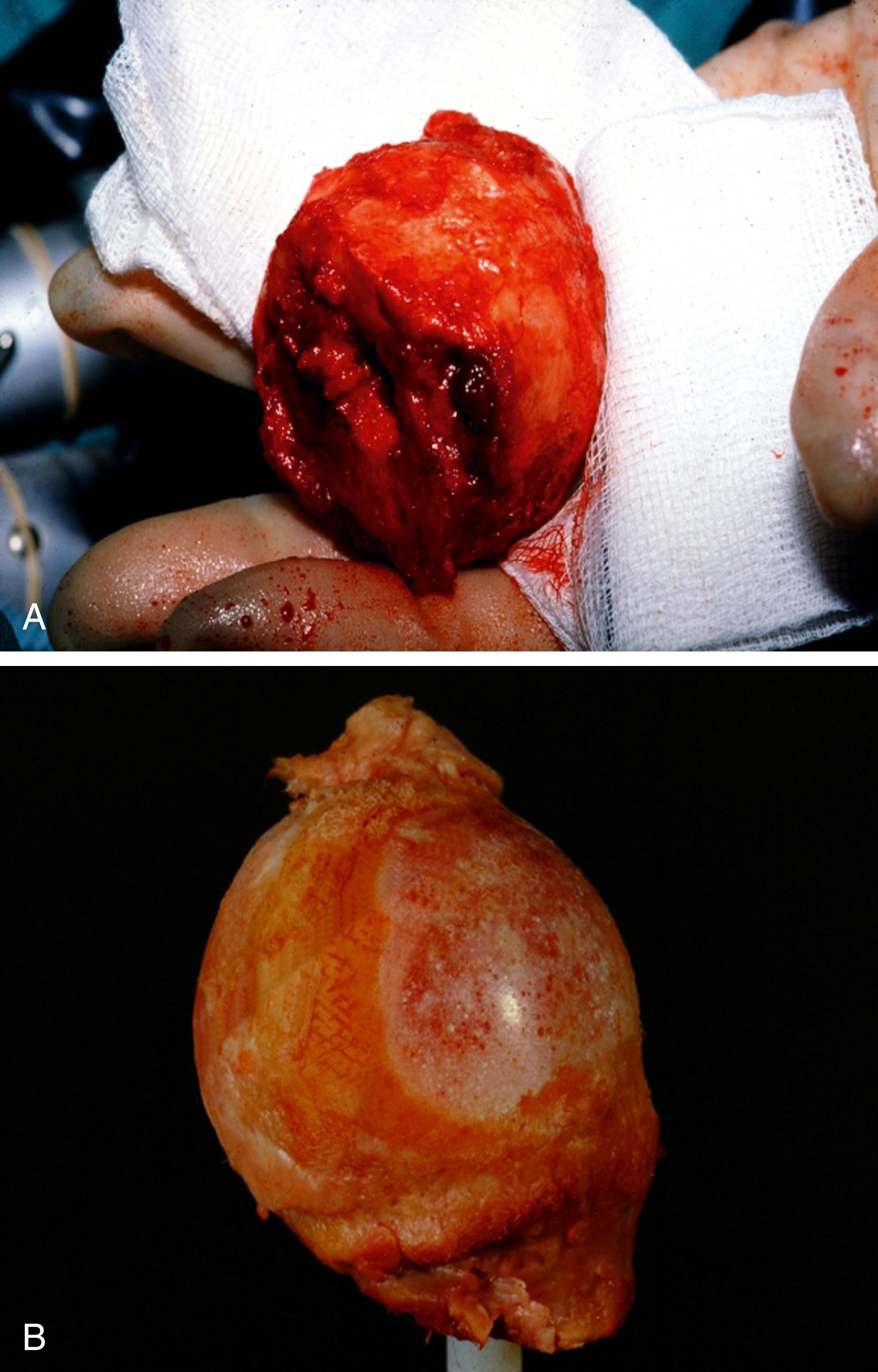
Orthopaedic patients usually present with pain or loss of function. It is possible that patients can misdiagnose the problem as originating from a different area, such as their back, shoulder or knee, for example, but this may be incorrect. The examining doctor may miss serious pathologies affecting other areas unless a careful general health history is taken and lateral thinking sometimes used. The list of potential errors is long so beware!
Important examples include:
a retroperitoneal, reticuloendothelial, gynaecological or prostatic problem presenting as backache;
lung cancer or cardiac disease masquerading as arm pain;
knee pain arising from the hip;
diabetes presenting for the first time as numbness, foot pain and paraesthesia.
In many parts of the world, orthopaedic and trauma surgeons have become the most likely specialists to be sued. To guard against future trouble, comprehensive contemporary notes must always be kept and it is good practice to copy any correspondence to the patient which should include a full explanation of what the problem is (as far as is known), what the management plan is and what (if any) alternative treatments are available, particularly if surgery is advocated. The risks of surgery must be fully explained and also the risk of not undergoing treatment.
Always, in the back of anyone’s mind who has undertaken paediatric orthopaedics, is the child’s physical development. The skeleton starts forming between the 6-8th week of intra-uterine life and reaches a stable state, usually, between 15 and 18 years. Obviously, the child’s development goes hand in hand with the rest of their physical and mental development. Normal development is put at risk by many diseases and injuries, both congenital and acquired. Inadequate treatment of paediatric orthopaedic problems can lead to a lifetime of disability.
The key to successful management is to understand the natural history of paediatric orthopaedic disorders; there are many conditions that appear very abnormal but turn out to grow normally if left alone; these are ‘normal variants’. These need to be distinguished from serious conditions. Paediatric orthopaedic surgeons work closely with paediatricians (particularly paediatric rheumatologists), geneticists and physiotherapists which allows them a better overview of the child, the disorder, the family setting and any inherited problem.
History taking includes the birth and delivery history, family history and developmental history including milestones. Fully examining the child may include watching them walk, run and play. Only by checking every aspect of the musculoskeletal system can one reassure a parent their child is normal.
Normal variants include conditions such as the majority of flat feet, metatarsus adductus, genu varum or valgus, persistent femoral anteversion or retroversion. Most ligamentous laxity is a normal variation or it can occur in specific conditions such as hip dysplasia and Marfan’s syndrome.
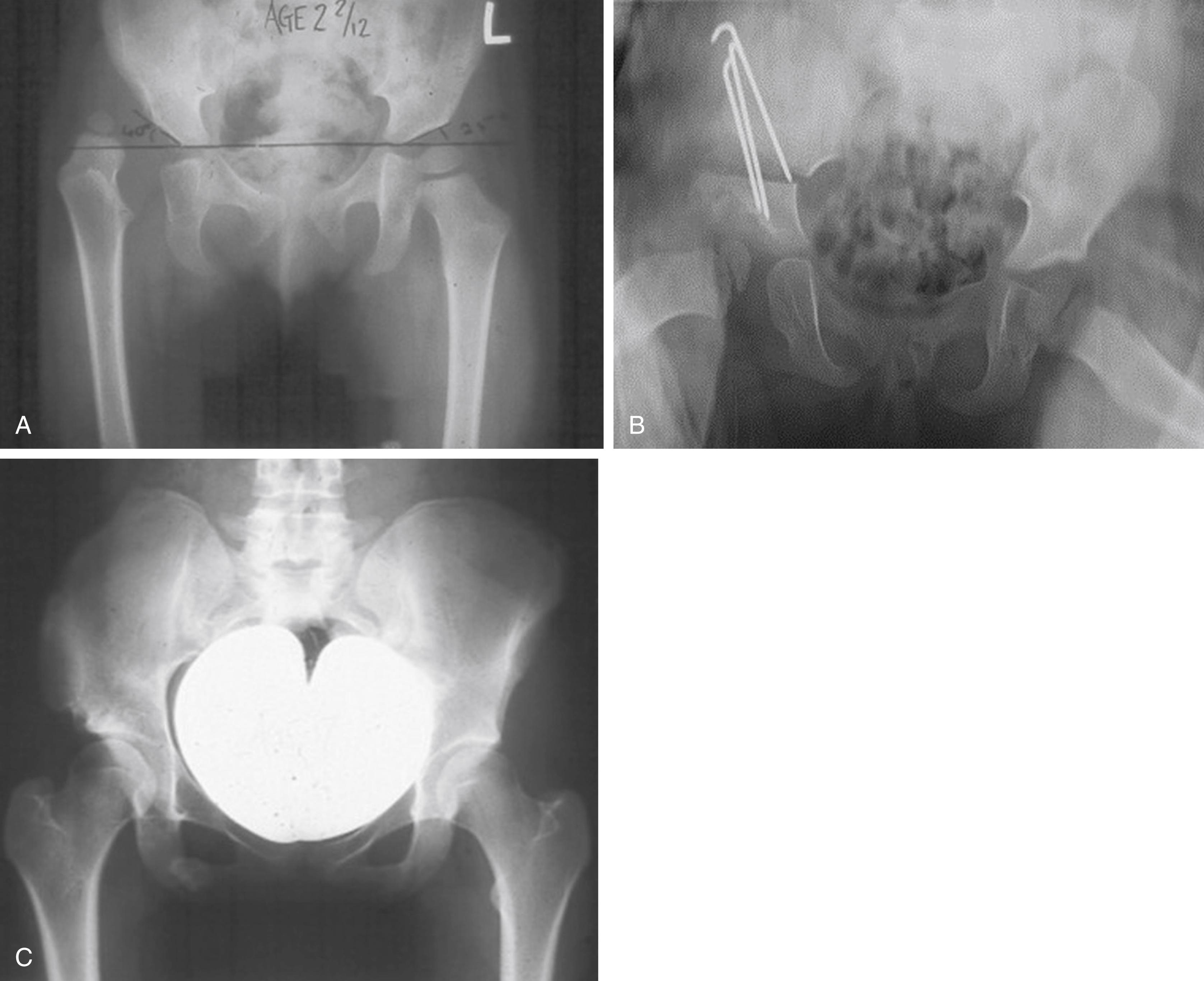
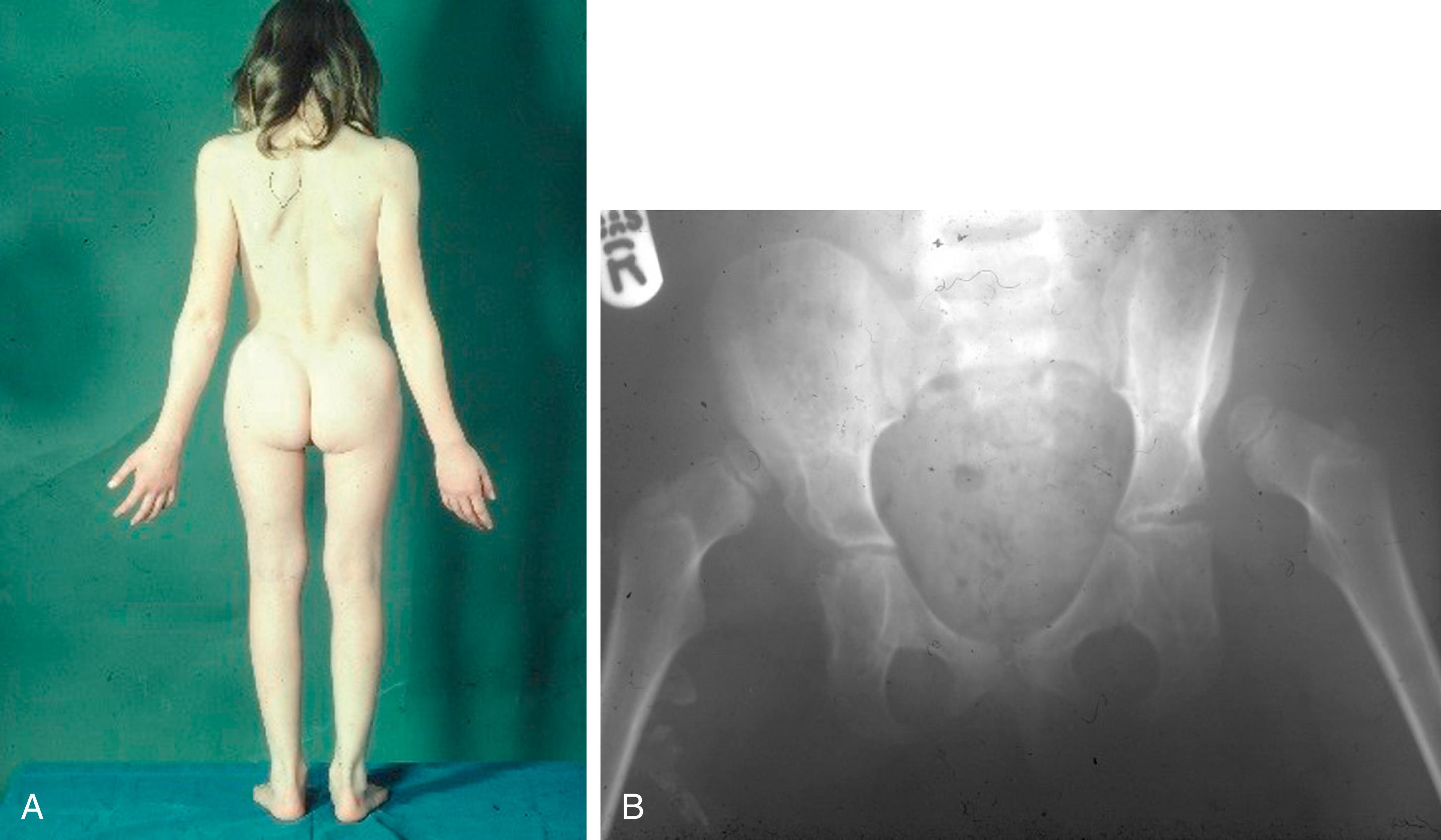
All children in developed countries are screened at birth for unstable hips using Barlow tests and seeking the Ortolani sign, and screened again at 6 to 8 weeks. Where there is doubt, or there is a family history of childhood hip problems, a breech birth, twin birth or premature delivery, ultrasound scanning should be performed. Girls are 10 times more frequently affected than boys. At this age, treatment is conservative, with a dynamic Pavlik Harness or similar device being worn for about 3 months.
Despite screening being in use for over 50 years, some children still present with a dislocated hip later than the newborn period. Under 1 year, treatment requires surgical adductor release or formal release of medial adductors, psoas and medial capsule and about 3 months in plaster. Later presentation still occurs when the child starts walking (and sometimes into the mid and late teens). The child presents with a painless Trendelenburg short leg limp, and markedly reduced hip abduction in flexion. The incidence remains stubbornly at 1:1000 births. The femoral head is found to be dislocated, with a dysplastic acetabulum, usually with a ‘false acetabulum’ on the ilium. Surgery involves stabilising the hip joint without damaging its blood supply and hence growth potential. A plaster cast (hip spica) is applied for about 8 weeks.
Boys are much more likely to develop Perthes disease and girls more often have dysplastic hips. Perthes usually manifests between 3 and 12 years. The cause is unclear but the pathology involves avascular necrosis of the femoral head ( Fig. 11.6 ). Spontaneous recovery occurs over 2 to 3 years but the final shape of the femoral head is critical in terms of later function. The outcome can be predicted from the radiological appearance. A poor outcome leads to premature hip arthritis; hip replacement is needed in 10% to 20%. Those that present before 5 to 6 years have the best outcomes.
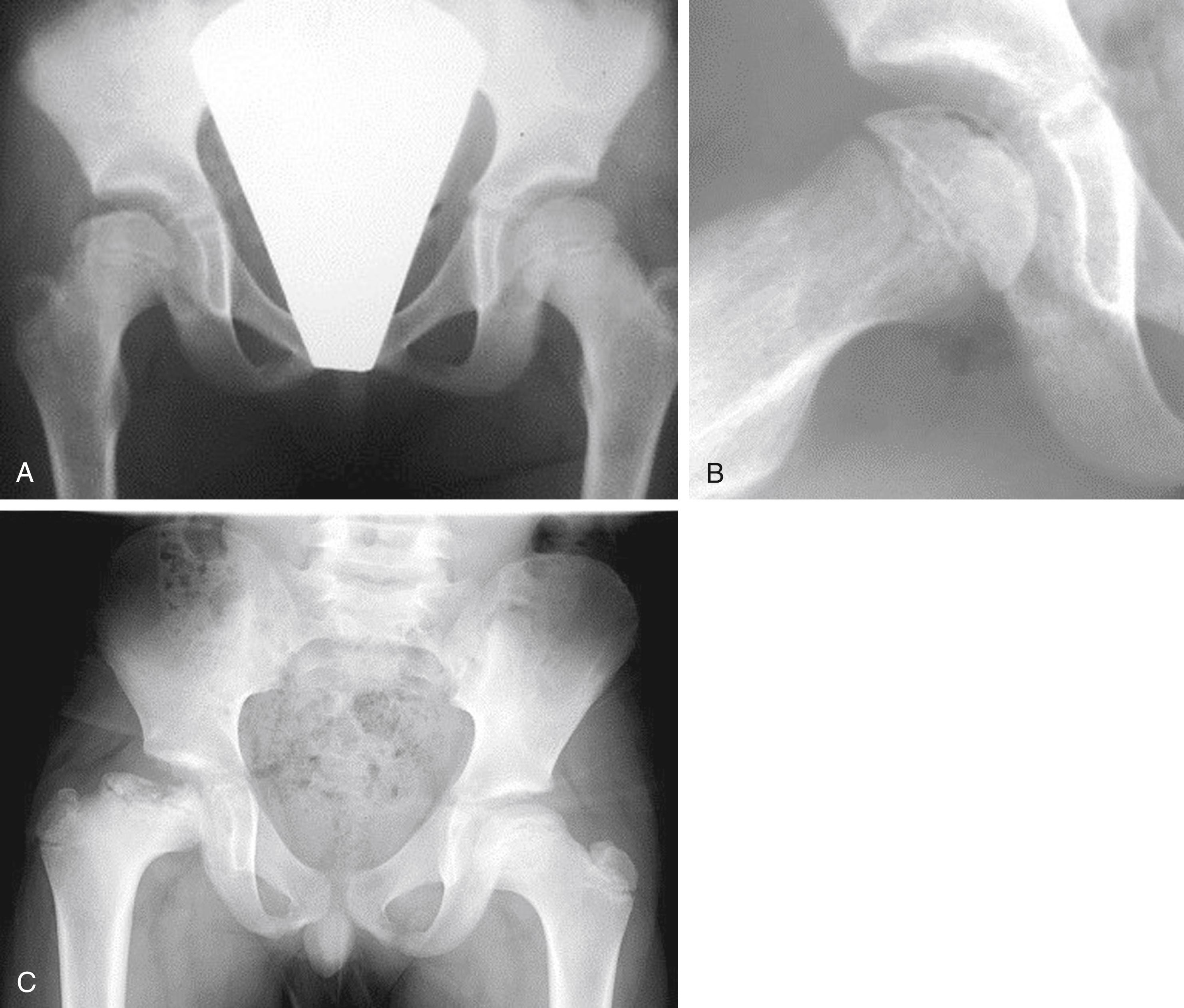
Restricting activity (often difficult) is the mainstay of treatment if the predicted outcome is good. If predicted to be poor, containment surgery involving realigning the proximal femur can be beneficial. Valgus osteotomy and a shelf procedure for the acetabulum is indicated in children who develop coxa plana and adduction deformity.
In this, the femoral head slips off the neck metaphysis at the epiphyseal plate ( Fig. 11.7 ); it can occur without significant trauma but can only occur if the growth plate is unfused. The presentation may be acute, acute-on-chronic or chronic. Traumatic slips are different and occur after extreme violence.
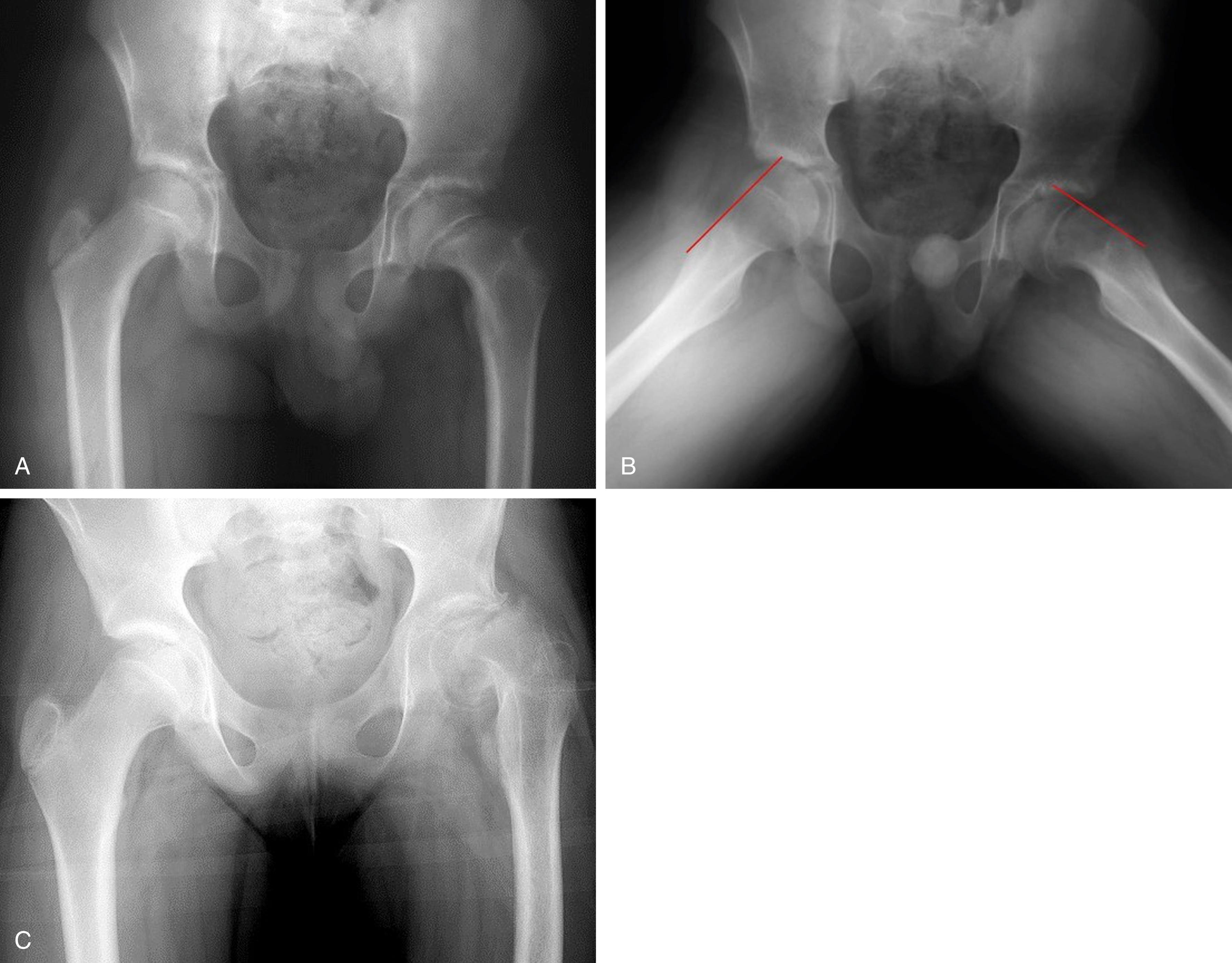
Slipped epiphysis presents with limping and pain, often in the knee. Many cases are missed because the hip is not examined. Signs include fixed flexion, markedly limited abduction and internal rotation, and the leg is often short. Typically, these children are overweight boys and short in stature.
Upon presentation, urgent diagnosis and treatment is crucial. Loder classified cases into those who can weight bear and those who cannot. The second group are surgical emergencies. Treatment always involves surgery. The slip is stabilised by passing a pin or specialised screw across the epiphysis. One screw is usually enough but accurate placement is technically demanding and should be undertaken only by experts. In severe slips, open reduction may be needed to avoid damaging the blood supply. Consideration should be given to prophylactic pinning of the contralateral hip. There is debate over this but the authors’ view is that it should be done if the parents do not understand the potential risks, or in a premenarche girl, or in a boy whose voice has not broken.
The long-term prognosis must always be guarded as there is a marked incidence of osteoarthritis in early or mid-adulthood. Occasionally, very mild symptoms have been assumed to be growing pains and the diagnosis made only when the patient presents with an arthritic hip.
Pain experienced in the knee is often referred from the hip; failure to assess the hip has often led to delay in recognising a serious hip problem.
Anterior knee pain is common in children between 11 and 16 years. Full assessment needs to be made but most eventually become asymptomatic without treatment.
Osgood–Schlatter and Larsen diseases both affect the tibial insertion and origin of the patellar ligament. The natural history is towards spontaneous resolution but can take 18 to 24 months. Both diseases cause activity related pain but usually resolve spontaneously. Placing the limb in a plaster cast for a month or so often speeds recovery. Osgood-Schlatter’s disease often leaves a permanently prominent tubercle.
Osteochondritis dissecans is where a section of articular cartilage dissects from its femoral condyle, usually affecting the lateral side of the medial condyle. Pain and instability are typical symptoms; an intercondylar x-ray demonstrates the lesion well and MRI can be helpful in determining treatment. Many spontaneously improve but unstable lesions need to be pinned and sometimes bone grafted.
Discoid lateral meniscus —rather than being semilunar, the lateral meniscus is solid and devoid of its central recess. The condition presents as pain in the outer side of the knee, instability and clicking or clunking. Conservative management should be followed where possible. The surgical option is to ‘re-sculpture’ it to resemble a normal lateral meniscus.
About 1:1000 children is born with club foot ( Fig. 11.8 ). For many years, early radical surgery was standard treatment. In this, all the ligaments around the joints of the hind-foot were incised, and the Achilles tendon and the flexor tendons lengthened. Nowadays Ponsetti’s nonoperative method of manipulating and splinting the foot is usually successful. Occasionally percutaneous division of the Achilles tendon is needed and can be done in the neonatal period under local anaesthesia. The results are excellent and these patients go on to live a normal life. The condition is often picked up during a prenatal maternal ultrasound scan and the parents can be reassured about the outcome, provided more serious conditions, such as spina bifida are absent.
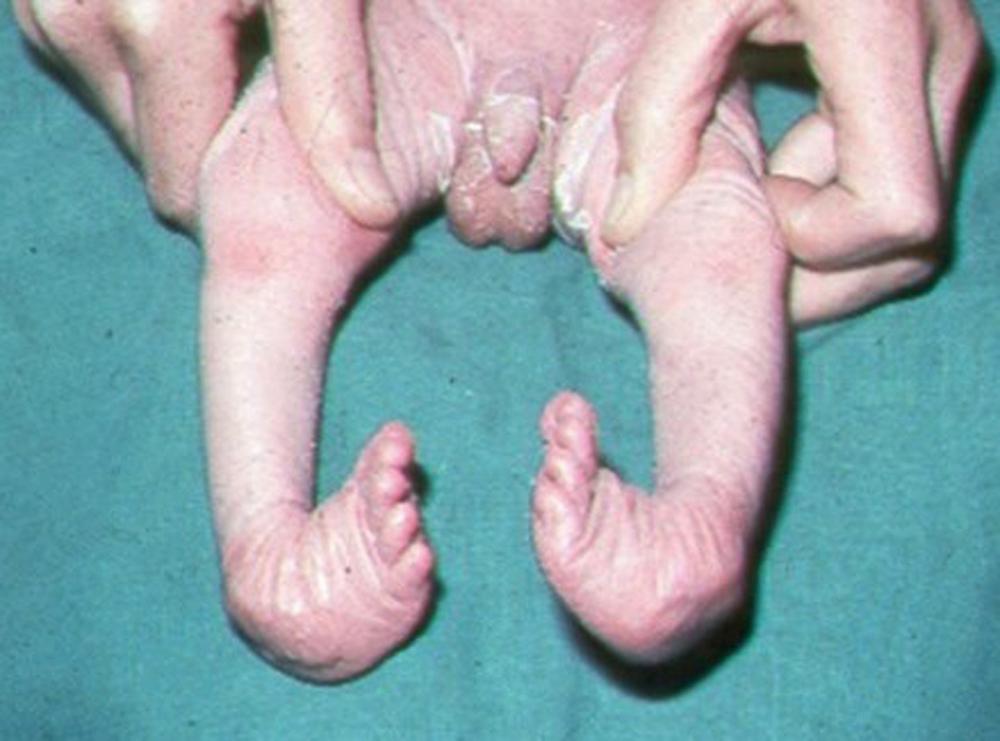
Pes Cavus is where the metatarsal heads lie below the heel in a neutral foot position. There is a high arch, a varus heel and usually wasting of small foot muscles. Colman’s block test helps to distinguish whether the hind foot is fixed or mobile. Pes cavus can be associated with polio, hereditary sensory and motor neuropathy (Charcot–Marie–Tooth disease), spina bifida and other spinal conditions, such as diastomatomyelia. Treatment involves orthoses or reconstructive surgery.
Limb bud failures are relatively common and account for a large number of congenital deformities, such as tibial or fibular dysplasia, proximal focal deficiency and radial club hand, among others.
Tarsal coalition is an example of failure of separation ( Fig. 11.9 ). The common types are talocalcaneal and calcaneonavicular. These coalitions can be fibrous, cartilaginous and most usually bony. They cause the child to complain of a painful foot. Examination confirms absence of hindfoot movement often with normal ankle movement. The treatment is either excision of the bar (if it is small) or surgical fusion of the subtalar and midfoot joint.
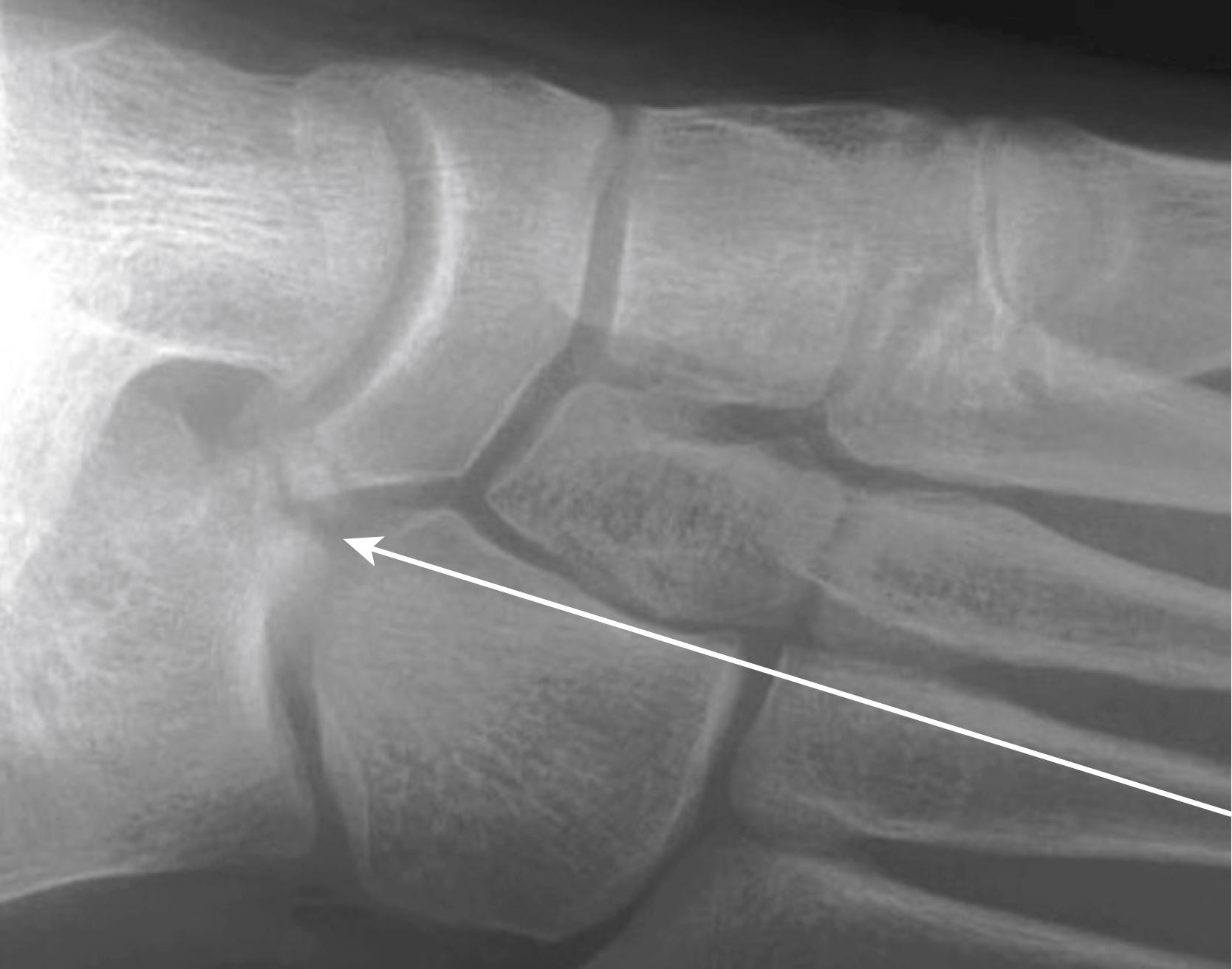
Various eponymous syndromes are common in a children’s orthopaedic clinic. It is worth remembering that learning difficulties plus two skeletal abnormalities strongly suggests a chromosomal problem.
Primary bone tumours in children are rare although Ewing sarcoma and osteosarcoma must be considered during teenage years. Reticuloses including leukaemia can present with skeletal pain. Bone cysts and remnants of ossification errors, such as cortical fibromas are often seen incidentally on x-ray. They are usually asymptomatic and need no treatment.
Orthopaedic infections can involve soft tissues or bone or both. Soft tissue infections include those of bursae adjoining joints, tendon sheaths of hands and feet and cellulitis. Diagnosis is relatively easy but treatment is difficult without leaving a residual functional deficit or stiffness. The outcome often depends on the pathogen. Fibrosis of upper limb tendons and sheaths develops quickly even after infection has been eradicated and can severely limit hand function.
These may result from traumatic penetration of a joint, therapeutic joint injections (iatrogenic), local spread from metaphyseal osteomyelitis (particularly with intracapsular metaphyses, i.e., hip, shoulder, knee, elbow), or by haematogenous spread from a remote infection. When a synovial joint fills with pus, articular cartilage is easily damaged and can break down within hours. The blood supply can become disrupted, so treatment is urgent.
Children , including neonates, can develop primary joint infections and these must be treated urgently. Staphylococcus aureus , Streptococcus pyogenes and gram-negative cocci are the most common pathogens, but many others have been recorded. A hip full of pus can dislocate.
On examination, the child is in pain, febrile and toxic. All movements are painful so in the very young, the condition may present as apparent paralysis (pseudo-paralysis). Investigations include a full blood count, ESR and CRP. Ultrasound and MRI are useful but may be difficult, and the child may require a general anaesthetic in order to perform the imaging.
Adults: primary joint infections are uncommon and most joints affected are already abnormal, often arthritic. The usual infecting organism in septic arthritis (and in primary osteomyelitis) is Staph. aureus , although Staph. pyogenes, Salmonella, Pseudomonas and other organisms, such as Neisseria can occur, more commonly in immunocompromised patients.
Diagnosis maybe delayed because it is thought that the increased pain is caused by progression of arthritis. Delay means severe pain and rapidly progressive joint damage which will increasingly compromise potential joint. Management involves emergency investigation and arthroscopic or open washing out and debridement of the joint, followed by antibiotic treatment tailored according to culture sensitvity results (from the joint aspirate).
Crystal arthropathy: Pseudogout (calcium pyrophosphate arthropathy) can mimic infection, as can gout (monosodium urate arthropathy). Joint aspiration followed by microscopy (looking for crystals with are positively or negatively birefringent, respectively) will confirm the diagnosis. Septic arthritis can coexist with gout and pseudogout, so joint aspirations should always be sent for cultures.
Joint Replacements can become infected at the time of operation or later by metastatic infection, even years after initial surgery.
Tuberculosis (TB) can affect any joint, as well as the spine. Nowadays, it is rare in the “developed” world but common where human immunodeficiency virus (HIV) is endemic. Infection slowly destroys the affected joint. Spinal TB can lead to paraplegia (Potts paraplegia) and large (‘cold’) abscesses may occur. Abscesses originating from the spine can present anywhere in the lower limb but most commonly in the groin. Typically, the patient suffers from the systemic symptoms of TB, which include night sweats, weight loss and general malaise. Nowadays, treatment is usually medical (i.e. with antibiotic therapy) even in the presence of large abscesses. Immobilisation and joint arthrodesis is used much less often than in the past.
Osteomyelitis is common in “developing countries” and often presents at an advanced stage. The organisms are essentially the same as those which occur in primary joint infections.
Until antibiotics became available, the mortality in the West from acute osteomyelitis in children was >80%, because of sepsis.
Acute osteomyelitis manly affects, but is not confined to, children. It is a very painful and it causes all the symptoms of septicaemia. In patients who have sickle cell disease, the important differential diagnosis to exclude is a sickle cell “crisis”. In acute osteomyelitis, the organism is usually identified from a blood culture and immediate treatment with antibiotics is usually effective. Surgical drainage is reserved for patients who fail to respond, or in abscess formation. It will progress to chronic osteomyelitis in neglected cases. Bone death ( sequestrum formation ), the production of a shell of new bone ( involucrum ) and the development of pus-draining sinuses may cause significant disability for the patient for the rest of their lives. The treatment of chronic osteomyelitis is often limited. Fucidic acid is often helpful during acute exacerbation and where appropriate, removal of sequestra is sometimes effective. Very occasionally massive resections of infected bone and total joint and bone replacement is indicated.
Brodie is a manifestation of chronic bone infection that has become walled off by healthy bone. It presents with chronic pain. Differential diagnosis includes osteoid osteoma. Treatment is by surgical curettage.
Diabetic foot problems of neuropathy and peripheral arterial disease are dealt with in Chapter 41 . Diabetic medical clinics ideally work closely with orthopaedic surgeons, vascular surgeons, podiatric services and orthotic departments to ensure optimal management and supply of appropriate footwear.
Diabetes can present as a peripheral neuropathy and can intensify the symptoms of carpal tunnel syndrome and spinal stenosis. Diabetes can be responsible for neuropathic or Charcot joints, particularly in the foot and ankle. Whenever a joint has ‘fallen to pieces’, remember diabetes, tertiary syphilis or syringomyelia (which most commonly occurs in the upper limb), particularly when there is marked sensory loss.
Infection after total knee replacement occurs about 10 times more frequently in patients with diabetes. Patients with long standing infection of a knee replacement run a substantial risk of amputation.
Cerebral Palsy (CP) is usually caused by an injury to the brain before, during, or shortly after birth, such as lack of oxygen or systemic illness. It is nonprogressive and affects upper motor neurones. The skeleton is initially normal but with growth, there is unbalanced paralysis around joints causing deformity, dislocations and contractures ( Fig. 11.10 ). Children with total body CP may have major learning difficulties, deafness, blindness or incontinence and are unlikely ever to walk. The pain and rigidity of dislocated hips or scoliosis can prevent them sitting upright in a wheelchair but surgery can often improve the situation: children with dislocated hips can have them reduced, scoliosis can be corrected and stabilised, and hemiplegia can benefit from lengthening of a contracted Achilles tendon.
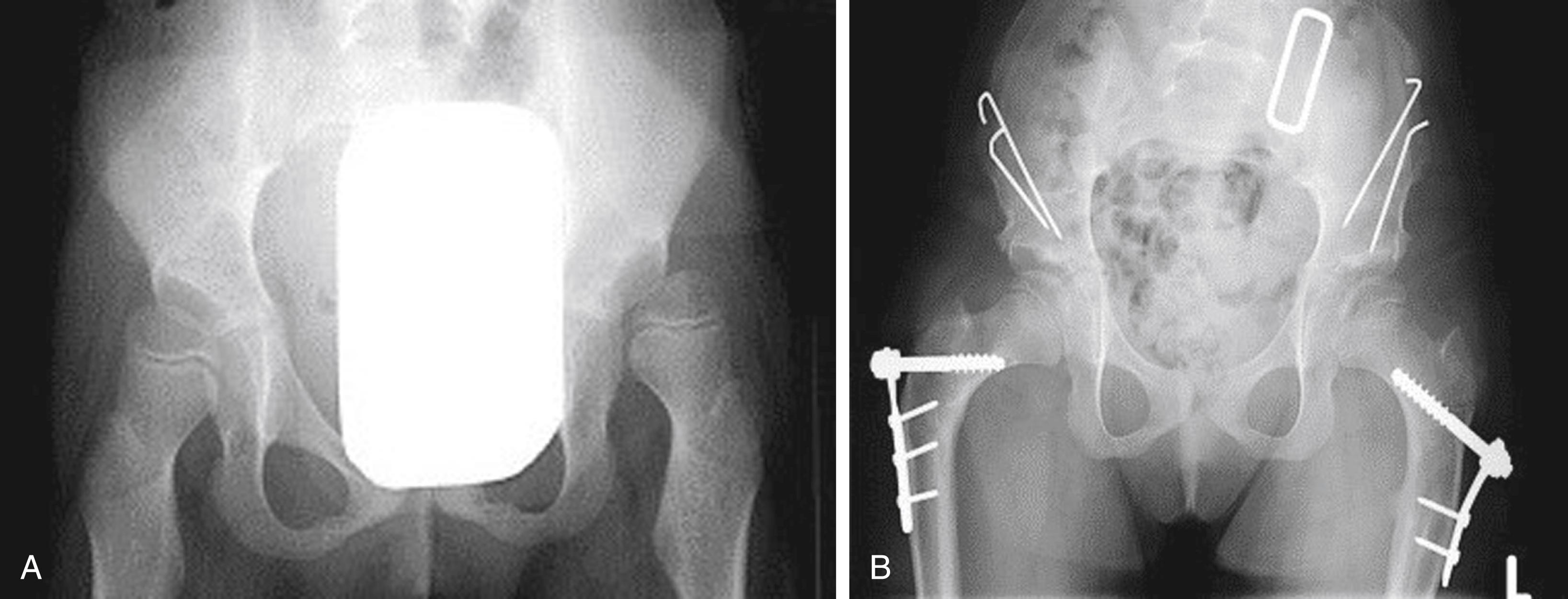
In adults, following a stroke, surgery for deformities and contractures is less successful but there are sometimes indications for tendon releases, particularly in patients who have not had suitable rehabilitation. Managing these patients is a team effort, often led by a physiotherapist.
Poliomyelitis is a viral disease affecting the anterior horn cells of the spinal cord. It can cause paralysis and this may be extensive or localised to one muscle group. It can cause death through respiratory muscle paralysis. Paralysis is often unbalanced, eventually leading to deformity and contractures. Spinal scoliosis is a common complication and can make respiration difficult. Splints and rehabilitative physiotherapy are vital and surgery can include arthrodesis of unstable joints and tendon transfers such as a tibialis posterior tendon transfer. Tibialis anterior is commonly affected whereas tibialis posterior is often spared. In these cases, tibialis posterior can be transferred through the interosseous membrane to the dorsum of the foot, so that the patient no longer needs to wear a foot drop splint.
Other peripheral neuropathies include Charcot–Marie–Tooth disease (which can cause peroneal muscular dystrophy) and other hereditary muscular dystrophies. These can lead to foot and ankle problems, such as pes cavus and foot drop. If splintage is not enough, surgery can be beneficial, until the unrelenting progress of the disease renders the patient immobile.
Become a Clinical Tree membership for Full access and enjoy Unlimited articles
If you are a member. Log in here